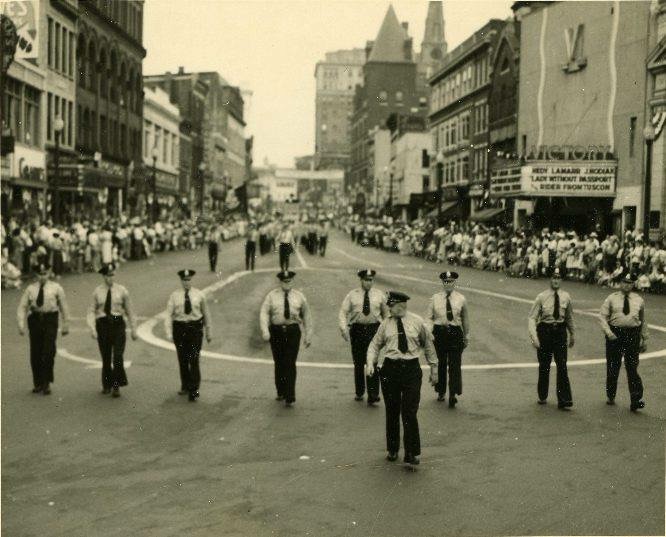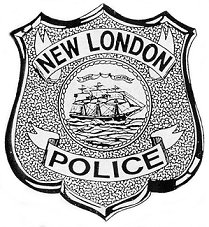History
No regular police force existed in New London until after the Civil War. Prior to this period the townspeople selected a constable (a peace officer, within a jurisdiction empowered to serve writs and warrants and to make arrests) at the annual town meeting. The constables had no beat or reported only when called. In the Common Council received pressure from citizens to establish a "night watch." but the business community did not want to pay the cost. Mayor J.N. Harris hired more constables to help keep order, but they could only serve 20-day periods at a time. He had to keep reappointing the same men for 20-day periods.

When Hiram Willey became mayor in 1862 he worked for a city "watch system" which was finally approved in September of 1864; as a result a 3 member police committee with powers to appoint was created and 8 men were appointed. The men were given clubs, bells, sockets and badges. They worked out of an apartment in the rear of the police court until February of 1865 when they were moved to the selectmen's rooms. They met each evening for instructions and then went on their beats. Each man received $2.00 per day, while the superintendent received $1.00. One watchman on day duty watched the trains 4 a.m. to 9 p.m. and passed on information on anything suspicious to the night men.
Many of the townspeople disliked the expense of a police force and wanted to return to a constable system where the salary came from fines. So much opposition developed that in December of 1865 a petition of 201 names was presented to council to end the force. It finally ended in June of 1866. With the demise of the "watch system" in 1866 conditions of crime and disorder became so bad that a movement by townspeople and local newspapers was begun in an appeal for protection. In 1867 a regular police force was requested to protect the town.
The first modern police force had its beginning in 1868 when a "night watch" received authorization by council. A small brick station was built on the East side of Potter Street, and was used from 1868 until 1898.The early New London Policemen had charge of streetlights and had to carry 5-gallon cans of fuel plus a stepladder in order to keep each light burning. No uniforms were worn until 1885; the familiar blue uniform did not appear until 1912. Police wore heavy helmets in summer and caps with earflaps in winter. Their salaries appeared to have always been political, so pay was subjected to the ups and downs of popular feelings in the community.

A new station was built on Bradley Street in 1897 and was ready in 1898. The new building provided offices, cells, a courtroom, records room, restrooms, and detention and consultation rooms. In 1903 a signal system for police was installed so that the station could contact an officer on the beat by turning on a red signal light indicating he should call the station. The department received its first patrol wagon in 1907;the two-way radio came into being in 1943.
Growth of the department continued on into the 1920's. The first woman with regular status was hired in 1923. In 1922 the department consisted of 46 men to serve a population of 25,000 citizens. A three-platoon system for police had now been developed but was abolished in 1923. After much discussion it was restored in 1929. A Detective Division began in 1927 with 2 detectives, a motorcycle policeman was added to the department during this period.
In 1924 there were problems within the department over promotions. City Manager Holt wanted examinations and department reorganization. As a result, Holt brought in two New York City Police Lieutenants to reorganize the department. Based on the review and recommendation of these two lieutenants, a reorganization, police manual and training school were proposed and carried out in 1925.
From the period of 1927 to 1946, the force had a restriction by directive to a limit of 40 patrolmen, 1 policewoman, 8 sergeants, 1 lieutenant and 1 captain.
A police union was formed in the early 60's to protect the working and wage conditions of its members. The union still exists today to assure benefits to its members.
In April of 1977, Samuel Fandel, a retired New York City Police Inspector, was hired and sworn in as Chief of the department. Chief Fandel came in and reorganized the department and served until his untimely death in March 1981 of cancer.
A new chief, Donald R. Sloan, was selected from within the ranks on May 7, 1981. Chief Sloan was a 32-year member of the New London Police Department, having had continuous service since November 18, 1950. Chief Sloan's policy and procedures were similar to that of former Chief Fandel. In 1985, the department moved to its new headquarters at 5 Governor Winthrop Boulevard. Chief Sloan retired in 1987.
In 1987 Richard Kistner, originally from the Midwest, was appointed Chief. Kistner initiated the computerization of the department and overhauled many of its policies and procedures. He left the department in 1993.
In 1993 Bruce F. Rinehart, a 30 year veteran of the department, was appointed Chief of Police. Chief Rinehart modernized the department's technological capabilities. Under his administration, The department obtained state-of-the-art computer equipment and software, including computer-aided dispatch, a new records management system, digitized mapping and mobile computers in police vehicles. Chief Rinehart also oversaw the department's move towards community policing. Relations between the community and the department have been strengthened as a result of these efforts.
In June of 2009, Chief Rinehart retired after over 40 years of service to the city.
In 2017, Peter Reichard, a former Assistant Chief with New Haven Police, was promoted to Chief of Police and is currently leading the NLPD into the age of community policing.
